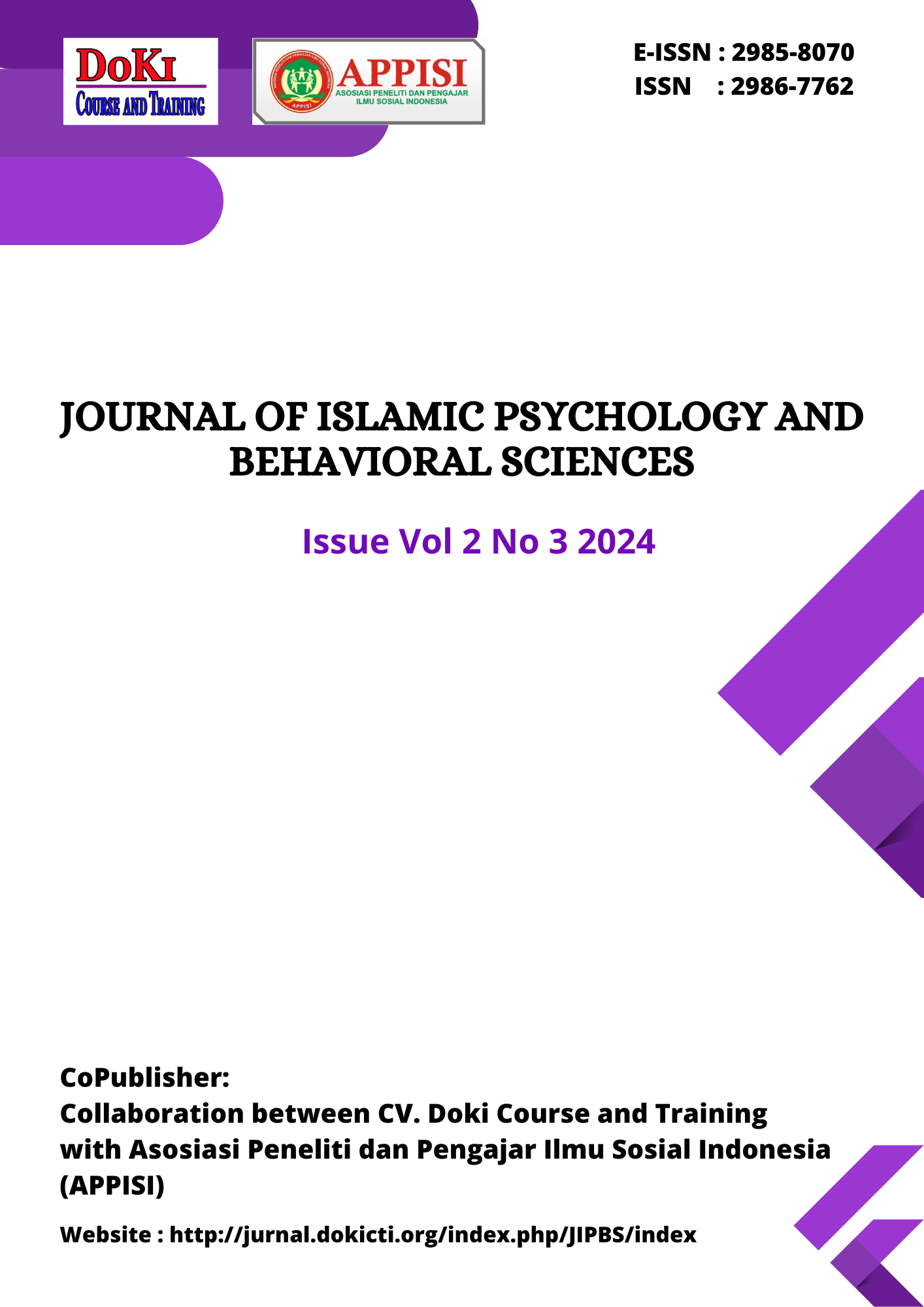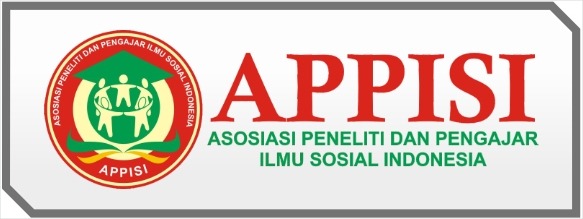Eksplorasi Konsep Non-Suicidal Self Injury Pada Pemuda Dan Potensi Kontribusi Perspektif Islam
DOI:
https://doi.org/10.61994/jipbs.v2i3.426Keywords:
Non-suicidal self-injury, Pemuda Muslim, Pemuda, Kesehatan MentalAbstract
Penelitian ini bertujuan untuk mengeksplorasi fenomena Non-Suicidal Self-Injury (NSSI) di kalangan remaja dari perspektif Islam. Penelitian ini menggali aspek spiritual, etika, dan kesehatan mental untuk memberikan pemahaman yang komprehensif. Pendekatan yang digunakan menggabungkan prinsip-prinsip Islam dengan perspektif kesehatan mental kontemporer untuk menawarkan wawasan tentang strategi pencegahan dan intervensi. Melalui metodologi scoping review, studi ini mensintesis literatur relevan dengan menggunakan kata kunci seperti "non-suicidal self-injury" untuk meneliti motivasi, faktor risiko, dan dampak psikologis. Diskusi ini mengintegrasikan ajaran Islam tentang kesehatan mental, etika perawatan diri, dan pentingnya mencari bantuan dalam komunitas yang mendukung. Temuan penelitian ini bertujuan untuk memberikan pemahaman holistik dan strategi yang sensitif secara budaya untuk menangani NSSI di kalangan remaja Muslim.
References
APA. (2013). American Psychiatric Association: Diagnostic and Statistical Manual on Mental Disorder (5th ed.). Arlington, VA: American Psychiatric Association.
Andover, M. S., Morris, B. W., Schatten, H. T., & Kelly, C. A. (2013). Assessment of Suicidal and Non-suicidal Self-injury in Anxiety Disorders. In Handbook of Assessing Variants and Complications in Anxiety Disorders (pp. 119-137). New York, NY: Springer New York. https://doi.org/10.1016/j.jaac.2011.04.003
Armoon, B., Mohammadi, R. & Griffiths, M.D. The Global Prevalence of Non-suicidal Self-injury, Suicide Behaviors, and Associated Risk Factors Among Runaway and Homeless Youth: A Meta-analysis. Community Ment Health J (2024). https://doi.org/10.1007/s10597-024-01245-y
Asarnow, J. R., Porta, G., Spirito, A., Emslie, G., Clarke, G., Wagner, K. D., ... & Brent, D. A. (2011). Suicide attempts and nonsuicidal self-injury in the treatment of resistant depression in adolescents: findings from the TORDIA study. Journal of the American Academy of Child & Adolescent Psychiatry, 50(8), 772-781.
Bjureberg, J., Kuja‐Halkola, R., Ohlis, A., Lichtenstein, P., D’Onofrio, B. M., Hellner, C., & Cederlöf, M. (2022). Adverse clinical outcomes among youths with nonsuicidal self‐injury and suicide attempts: A longitudinal cohort study. Journal of child psychology and psychiatry, 63(8), 921-928. https://doi.org/10.1111/jcpp.13544
Bjureberg, J., Ojala, O., Rasmusson, B., Malmgren, J., Hellner, C., & Flygare, O. (2024). Cost-effectiveness of Internet-Delivered Emotion Regulation Therapy for Adolescents With Nonsuicidal Self-injury. https://doi.org/10.31234/osf.io/93kjw
Chandan, J. S., Thomas, T., Gokhale, K. M., Bandyopadhyay, S., Taylor, J., & Nirantharakumar, K. (2019). The burden of mental ill health associated with childhood maltreatment in the UK, using The Health Improvement Network database: a population-based retrospective cohort study. The Lancet Psychiatry, 6(11), 926-934. https://doi.org/10.1016/S2215-0366(19)30369-4
Copeland, W. E., Angold, A., Shanahan, L., & Costello, E. J. (2014). Longitudinal patterns of anxiety from childhood to adulthood: the Great Smoky Mountains Study. Journal of the American Academy of Child & Adolescent Psychiatry, 53(1), 21-33. https://doi.org/10.1016/j.jaac.2013.09.017
Fisher, A. C., Rushby, J. A., McDonald, S., Parks, N., & Piguet, O. (2015). Neurophysiological correlates of dysregulated emotional arousal in severe traumatic brain injury. Clinical Neurophysiology, 126(2), 314-324. https://doi.org/10.1016/j.clinph.2014.05.033
Gu, H., Chen, W., & Cheng, Y. (2024). Longitudinal relationship between harsh parenting and adolescent non-suicidal self-injury: The roles of basic psychological needs frustration and self-concept clarity. Child Abuse & Neglect, 149, 106697. https://doi.org/10.1016/j.chiabu.2024.106697
Han, S. (2019). Influencing factors of adolescent self-injury behavior. Advances in Psychology, 9(2), 248-54. https://doi.org/10.12677/ap.2019.92032
Hawton, K., Saunders, K. E., & O'Connor, R. C. (2012). Self-harm and suicide in adolescents. The lancet, 379(9834), 2373-2382. https://doi.org/10.1016/S0140-6736(12)60322-5
Haywood, Hasking & Boyes (2024) Untangling the link between experiential avoidance and non-suicidal self-injury: a multidimensional approach, Australian Journal of Psychology, 76:1, 2315951, https://doi.org/10.1080/00049530.2024.2315951
Hooley, J. M., & Franklin, J. C. (2018). Why do people hurt themselves? A new conceptual model of nonsuicidal self-injury. Clinical psychological science, 6(3), 428-451. https://doi.org/10.1177/2167702617745641
Islam, S., Akter, R., Sikder, T., & Griffiths, M. D. (2020). Prevalence and factors associated with depression and anxiety among first-year university students in Bangladesh: a cross-sectional study. International Journal of Mental Health and Addiction, 1-14. https://doi.org/10.1007/s11469-020-00242-y
Joiner, T. (2024). 1 Suicide: The Interpersonal Theory of Suicide. In The Varieties of Suicidal Experience (pp. 49-66). New York University Press. https://doi.org/10.18574/nyu/9781479823505.003.0004
Kao H-T, Mürner-Lavanchy I, von Stosch E, Josi J, Berger T, Koenig J, Kaess M (2024). Pain sensitivity as a state marker and predictor for adolescent non-suicidal selfinjury. Psychological Medicine 1–8. https://doi.org/10.1017/S0033291724000461
Kiekens, G., Robinson, K., Tatnell, R., & Kirtley, O. J. (2021). Opening the black box of daily life in nonsuicidal self-injury research: with great opportunity comes great responsibility. JMIR Mental Health, 8(11), e30915. doi: 10.2196/30915
Klonsky, E. D., & Muehlenkamp, J. J. (2007). Self‐injury: A research review for the practitioner. Journal of clinical psychology, 63(11), 1045-1056. https://doi.org/10.1002/jclp.20412
Kuburi, S., Ewing, L., Hamza, C. A., & Goldstein, A. L. (2024). A daily diary study of the relation between stress and nonsuicidal self-injury and the moderating role of emotion dysregulation in emerging adulthood. Journal of youth and adolescence, 1-10. https://doi.org/10.1007/s10964-024-01946-3
Lereya, S. T., Copeland, W. E., Costello, E. J., & Wolke, D. (2015). Adult mental health consequences of peer bullying and maltreatment in childhood: two cohorts in two countries. The Lancet Psychiatry, 2(6), 524-531. https://doi.org/10.1016/S2215-0366(15)00165-0
Lesthari, F., & Permana, M. Z. (2022). Pengalaman Membangun Cita-Cita serta Tujuan Hidup pada Usia Emerging Adulthood: Analisa Fenomenologi. Jurnal Ilmiah Psikologi Insani, 7(2).
Linqi Zhou, Changyuan Qiao, Jialing Huang, Jian Lin, Haisheng Zhang, Jian Xie, Yonggui Yuan & Changchun Hu (2024) The Impact of Recent Life Events, Internalizing Symptoms, and Emotion Regulation on the Severity of Non-Suicidal Self-Injury in Adolescents: A Mediation Analysis, Neuropsychiatric Disease and Treatment, , 415-428, https://doi.org/10.2147/NDT.S444729
Liu, L., De Vel, O., Han, Q. L., Zhang, J., & Xiang, Y. (2018). Detecting and preventing cyber insider threats: A survey. IEEE Communications Surveys & Tutorials, 20(2), 1397-1417. DOI: 10.1109/COMST.2018.2800740
Littleton, L. L., Rehbein, D. M., Barber, J. J., & Muehlenkamp, J. J. (2024). Testing Suicide Ideation-to-Action Theory Differences Among Those With Nonsuicidal Self-Injury. Archives of Suicide Research, 1-12. https://doi.org/10.1080/13811118.2024.2323589
Mars, B., Heron, J., Klonsky, E. D., Moran, P., O'Connor, R. C., Tilling, K., ... & Gunnell, D. (2019). Predictors of future suicide attempt among adolescents with suicidal thoughts or non-suicidal self-harm: a population-based birth cohort study. The Lancet Psychiatry, 6(4), 327-337. https://doi.org/10.1016/S2215-0366(19)30030-6
Mellin, J. E., Young, C. C., Rew, L., Zuniga, J., & Monge, M. C. (2024). Sexual Activity as Self-Injury: A Scoping Review. The Journal of Sex Research, 1-14. https://doi.org/10.1080/00224499.2024.2320828
Nam, R. J., & Cha, C. B. (2024). Latent classes of episodic future thinking among suicidal and nonsuicidal community adolescents. https://doi.org/10.17605/OSF.IO/CBDYZ
Nock, M. K. (2010). Self-injury. Annual review of clinical psychology, 6, 339-363. DOI: https://doi.org/10.1146/annurev.clinpsy.121208.131258
O'Loughlin, C. M., McClure, K., & Ammerman, B. A. (2024). Development and validation of the self-injury stigma scale. Journal of Psychiatric Research. https://doi.org/10.1016/j.jpsychires.2024.02.027
Olweus, D. (2013). School bullying: Development and some important challenges. Annual review of clinical psychology, 9, 751-780. https://doi.org/10.1146/annurev-clinpsy-050212-185516
Olweus, D. (2013). Bully/victim problems among schoolchildren: Basic facts and effects of a school based intervention program. In The development and treatment of childhood aggression (pp. 411-448). Psychology Press.
Park, Y., Qu, W., & Ammerman, B. A. (2024). Characteristics and functions of non-suicidal self-injury that inform suicide risk. Archives of suicide research, 1-14. https://doi.org/10.1080/13811118.2024.2310556
Permana, M. Z. (2020). Pengembangan Identitas Baru: Konsep Perluasan Diri dalam Relasi Interpersonal. Psikologi untuk Indonesia: Isu isu terkini relasi sosial dari intrapersonal hingga interorganisasi, 43.
Permana, M. Z., & Medynna, A. D. N. (2021). Ribet!: Persepsi Menikah pada Emerging Adulthood. Psikostudia: Jurnal Psikologi, 10(3), 248-257. DOI: 10.30872/psikostudia
Permana, Z., Koentjoro, K., & Azca, M. N. (2023). Toxic Relationship in Emerging Adulthood. Jurnal Wanita dan Keluarga, 4(1), 88-105. https://doi.org/10.22146/jwk.8765
Permana, M. Z. (2021). Mengenal Dasar-Dasar Emosi Dalam Menghadapi Pandemi. Plakat: Jurnal Pelayanan Kepada Masyarakat, 3(1), 26-42.
Permana, M. Z., & Lesthari, F. (2022). Mengapa Hidup yang Abstrak Membuat Cita-Cita Lebih Abstrak. Gambaran Cita-Cita Mahasiswa di Fakultas Psikologi UNJANI). PSIKOLOGI KONSELING, 20(1), 1377-1389.
Permana, M. Z., & Riyani, P. TOLERANSI; Sebuah Konsep Psikologi. TOLERANSI: Media Ilmiah Komunikasi Umat Beragama, 15(2), 93-103. http://dx.doi.org/10.24014/trs.v15i2.28280
Pourramzani A, Gharaei Nejad K, Sayar S. Alexithymia and Suicidal Ideation in Iranian Patients With Psoriasis. Caspian J Neurol Sci 2024; 10 (2) :117-125 http://dx.doi.org/10.32598/CJNS.10.37.440.1
Ribeiro, J. D., Franklin, J. C., Fox, K. R., Bentley, K. H., Kleiman, E. M., Chang, B. P., & Nock, M. K. (2016). Self-injurious thoughts and behaviors as risk factors for future suicide ideation, attempts, and death: a meta-analysis of longitudinal studies. Psychological medicine, 46(2), 225-236. https://doi.org/10.1017/S0033291715001804
Ruan, Q.-N., Liu, L., Shen, G.-H., Wu, Y.-W., & Yan, W.-J. (2024). Alexithymia and peer victimisation: interconnected pathways to adolescent non-suicidal self-injury. BJPsych Open, 10(2), e46. doi:10.1192/bjo.2023.653
Seong, E., Lee, K. H., Lee, J. S., Kim, S., Seo, D. G., Yoo, J. H., ... & Kim, J. W. (2024). Depression and posttraumatic stress disorder in adolescents with nonsuicidal self-injury: comparisons of the psychological correlates and suicidal presentations across diagnostic subgroups. BMC psychiatry, 24(1), 138. https://doi.org/10.1186/s12888-024-05533-5
Steggals, P., Graham, R., & Lawler, S. (2024). Nonsuicidal self-injury and intersubjective recognition:‘You can’t argue with wounds’. The Sociological Review, 00380261231221661. https://doi.org/10.1177/00380261231221661
Swannell, S. V., Martin, G. E., Page, A., Hasking, P., & St John, N. J. (2014). Prevalence of nonsuicidal self‐injury in nonclinical samples: Systematic review, meta‐analysis and meta‐regression. Suicide and Life‐Threatening Behavior, 44(3), 273-303. https://doi.org/10.1111/sltb.12070
Turecki, G., Ernst, C., Jollant, F., Labonté, B., & Mechawar, N. (2012). The neurodevelopmental origins of suicidal behavior. Trends in neurosciences, 35(1), 14-23. https://doi.org/10.1016/j.tins.2011.11.008
Victor, S. E., & Klonsky, E. D. (2014). Correlates of suicide attempts among self-injurers: A meta-analysis. Clinical psychology review, 34(4), 282-297. https://doi.org/10.1016/j.cpr.2014.03.005
Wang, H., Xu, S., Wang, S., Wang, Y., & Chen, R. (2024). Using decision tree to predict non-suicidal self-injury among young adults: the role of depression, childhood maltreatment and recent bullying victimization. European Journal of Psychotraumatology, 15(1), 2322390. https://doi.org/10.1080/20008066.2024.2322390
Wang, Z., Li, D., Chen, Y., Tao, Z., Jiang, L., He, X., & Zhang, W. (2024). Understanding the subtypes of non-suicidal self-injury: A new conceptual framework based on a systematic review. Psychiatry Research, 115816.
DOI: https://doi.org/10.1016/j.psychres.2024.115816
Wang, Z., Li, D., Chen, Y., Tao, Z., Jiang, L., He, X., & Zhang, W. (2024). Understanding the subtypes of non-suicidal self-injury: A new conceptual framework based on a systematic review. Psychiatry Research, 115816. https://doi.org/10.1016/j.psychres.2024.115816
Wang, Z., Chen, Y., Tao, Z., Yang, M., Li, D., Jiang, L., & Zhang, W. (2024). Quantifying the importance of non-suicidal self-injury characteristics in predicting different clinical outcomes: using random forest model. Journal of youth and adolescence, 1-15. https://doi.org/10.1007/s10964-023-01926-z
Wichstrøm, T., & Wichstrøm, L. (2024). Childhood Predictors of Nonsuicidal Self-Injury in Adolescence: A Birth Cohort Study. Journal of the American Academy of Child & Adolescent Psychiatry. https://doi.org/10.1016/j.jaac.2023.12.013
Zhou, S. C., Zhou, Z., Tang, Q., Yu, P., Zou, H., Liu, Q., ... & Luo, D. (2024). Prediction of non-suicidal self-injury in adolescents at the family level using regression methods and machine learning. Journal of affective disorders. https://doi.org/10.1016/j.jad.2024.02.039
Zhu, J., Zhang, W., Chen, Y., & Teicher, M. H. (2024). Joint Trajectories of Depression and Rumination: Experiential Predictors and Risk of Nonsuicidal Self-Injury. Journal of the American Academy of Child & Adolescent Psychiatry. https://doi.org/10.1016/j.jaac.2024.01.014
Downloads
Published
Issue
Section
License
Copyright (c) 2024 Zein Permana

This work is licensed under a Creative Commons Attribution-ShareAlike 4.0 International License.

Journal of Islamic Psychology and Behavioral Sciences by https://jurnal.dokicti.org/index.php/JIPBS/index
is licensed under a Creative Commons Attribution-ShareAlike 4.0 International Licensel












